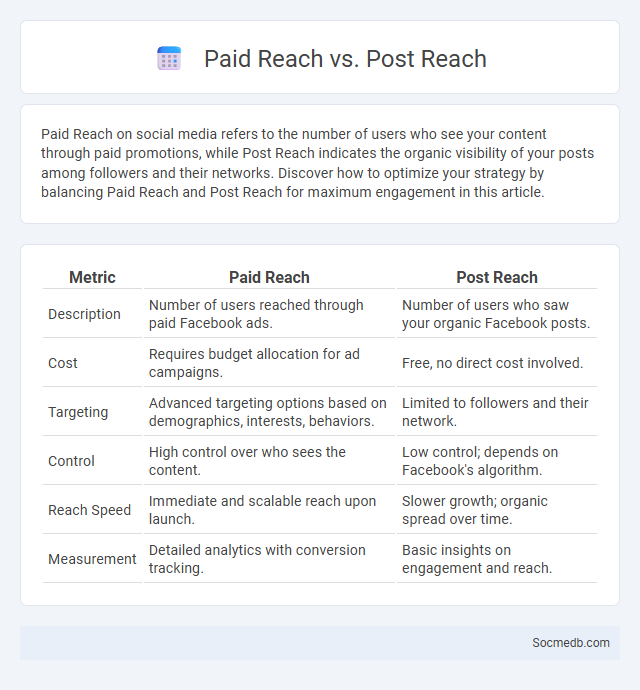
Photo illustration: Paid Reach vs Post Reach
Paid Reach on social media refers to the number of users who see your content through paid promotions, while Post Reach indicates the organic visibility of your posts among followers and their networks. Discover how to optimize your strategy by balancing Paid Reach and Post Reach for maximum engagement in this article.
Table of Comparison
| Metric | Paid Reach | Post Reach |
|---|---|---|
| Description | Number of users reached through paid Facebook ads. | Number of users who saw your organic Facebook posts. |
| Cost | Requires budget allocation for ad campaigns. | Free, no direct cost involved. |
| Targeting | Advanced targeting options based on demographics, interests, behaviors. | Limited to followers and their network. |
| Control | High control over who sees the content. | Low control; depends on Facebook's algorithm. |
| Reach Speed | Immediate and scalable reach upon launch. | Slower growth; organic spread over time. |
| Measurement | Detailed analytics with conversion tracking. | Basic insights on engagement and reach. |
Introduction to Reach Metrics
Reach metrics measure the total number of unique users who have seen a particular social media post or campaign, offering insight into content visibility and audience exposure. These metrics help marketers evaluate the effectiveness of their content distribution strategies across platforms like Facebook, Instagram, and Twitter. Understanding reach is crucial for optimizing engagement rates and increasing brand awareness in targeted demographics.
Defining Paid Reach
Paid reach refers to the total number of unique users who see your content as a result of paid advertisements or promotions on social media platforms. This metric is crucial for measuring the effectiveness of campaigns on Facebook, Instagram, Twitter, and LinkedIn by quantifying audience engagement driven through sponsored posts or ads. Tracking paid reach helps marketers optimize budget allocation and improve return on investment (ROI) in digital advertising strategies.
Understanding Organic Post Reach
Understanding organic post reach on social media is crucial for maximizing your content's visibility without paid promotion. Organic reach measures the number of unique users who see your posts naturally through shares, likes, or algorithmic exposure, reflecting genuine audience engagement. Optimizing content relevance, posting time, and interaction can significantly enhance your organic reach and foster authentic connections with your followers.
Key Differences: Paid Reach vs Post Reach
Paid reach refers to the audience size achieved through sponsored or promoted content that you pay to distribute, often targeting specific demographics or interests. Post reach is the organic number of unique users who see your content without paid promotion, reflecting natural visibility based on engagement and follower activity. You should analyze both metrics to optimize your social media strategy, balancing budget allocation with content quality to maximize overall exposure.
How Paid Reach Works on Social Platforms
Paid reach on social media platforms involves businesses paying to have their content displayed to a targeted audience beyond their organic followers. Algorithms prioritize paid content based on factors like bid amount, ad relevance, and audience engagement, maximizing visibility for your campaigns. Understanding these mechanisms helps you optimize ad spend and improve the effectiveness of your social media marketing strategies.
Measuring the Effectiveness of Each Reach Type
Measuring the effectiveness of each social media reach type involves analyzing metrics such as engagement rate, conversion rate, and audience retention specific to organic, paid, and viral reach. Tools like Facebook Insights, Twitter Analytics, and Instagram Insights provide detailed data on impressions, click-through rates, and demographic reach, enabling precise evaluation. Understanding these metrics helps optimize content strategy and budget allocation to maximize overall campaign performance.
Benefits and Drawbacks of Paid Reach
Paid reach on social media enhances brand visibility by targeting specific demographics, increasing engagement rates and driving higher conversion rates through tailored ads. However, it can be costly and may lead to ad fatigue among users, reducing long-term organic growth and authenticity. Balancing paid campaigns with organic strategies ensures sustainable audience development and maximizes overall marketing ROI.
When to Prioritize Post Reach Over Paid Reach
Prioritize post reach over paid reach when you want to build organic engagement and foster authentic community interactions on social media platforms. Your content is more likely to gain genuine visibility and credibility when users engage naturally, which can boost long-term brand loyalty. Focusing on organic reach is especially effective during product launches, announcements, or sharing valuable content that resonates deeply with your target audience.
Strategies to Optimize Both Paid and Organic Reach
Maximize your social media impact by integrating targeted paid ads with consistent organic content tailored to audience behavior and platform algorithms. Leverage analytics to refine ad spend while boosting engagement through authentic posts, interactive stories, and timely responses to follower interactions. Your strategic balance between paid campaigns and organic reach ensures sustainable growth and improved brand visibility.
Making Data-Driven Decisions: Choosing the Right Reach Approach
Making data-driven decisions in social media requires analyzing engagement metrics like click-through rates, impressions, and audience demographics to select the most effective reach strategy. Understanding your target audience's behavior allows you to optimize content distribution across platforms such as Facebook, Instagram, and LinkedIn, enhancing brand visibility and conversion rates. Your ability to leverage these insights ensures that marketing efforts maximize ROI by focusing on high-impact channels and messaging.
 socmedb.com
socmedb.com